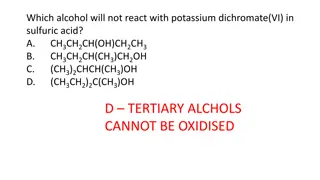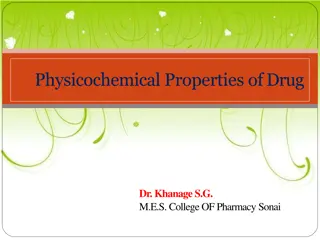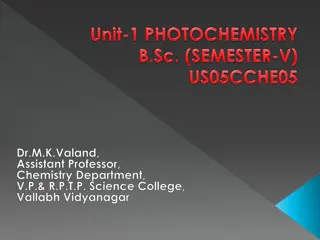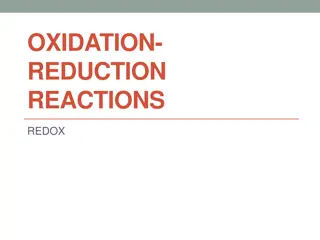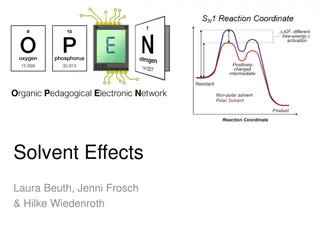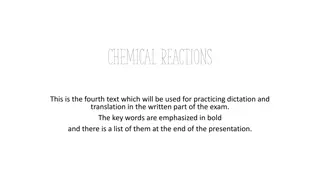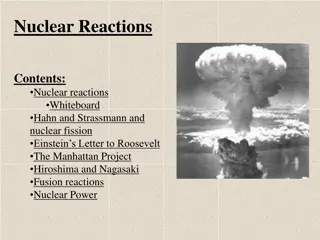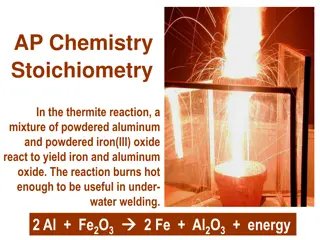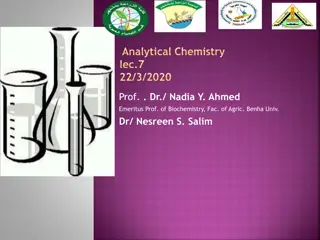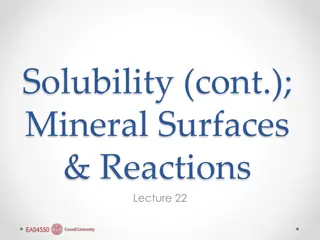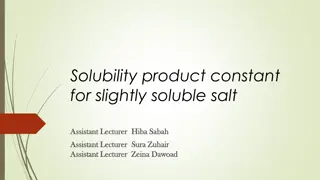Chemistry Lecture: Solubility and Reactions
This lecture covers topics such as sparingly soluble salts, solubility in water, common ion effects, precipitation, selective precipitation, complex ions, thermodynamics, equilibrium, solubility product problems, and more. Explore examples and calculations related to solubility and spontaneous reactions in chemistry.
Download Presentation

Please find below an Image/Link to download the presentation.
The content on the website is provided AS IS for your information and personal use only. It may not be sold, licensed, or shared on other websites without obtaining consent from the author.If you encounter any issues during the download, it is possible that the publisher has removed the file from their server.
You are allowed to download the files provided on this website for personal or commercial use, subject to the condition that they are used lawfully. All files are the property of their respective owners.
The content on the website is provided AS IS for your information and personal use only. It may not be sold, licensed, or shared on other websites without obtaining consent from the author.
E N D
Presentation Transcript
Announcements Statistical Calculations Lab Due today AA Lab Tap water data posted online Today s Lecture Chapter 6 Parts missed last time Sparingly Soluble Salts Solubility in water Solubility in common ion Precipitation + Selective Precipitation Complex Ions
Example question The reaction N2(g) + O2(g) positive H. Under what conditions is this process spontaneous? - all temperatures - low temperatures - high temperatures - never 2NO(g) has a
Thermodynamics G and Equilibrium G = G + RTlnQ Q = Reaction Quotient (for A B, Q = [B]/[A]) At equilibrium, G = 0 and Q = K G = -RTlnK
Solubility Product Problems - Solubility in Water Example: solubility of Mg(OH)2in water Solubility defined as mol Mg(OH)2dissolved/L sol n or g Mg(OH)2dissolved/L sol n or other units Use ICE approach: Mg(OH)2(s) Mg2++ 2OH- 0 +x x Initial Change Equilibrium 0 +2x 2x Note: x = [Mg2+] = solubility
Solubility Product Problems - Solubility of Mg(OH)2 in water Equilibrium Equation: Ksp = [Mg2+][OH-]2 Ksp = 7.1 x 10-12 = x(2x)2 = 4x3 (see Appendix F for Ksp) x = (7.1 x 10-12/4)1/3 = 1.2 x 10-4 M Solubility = 1.2 x 10-4 M = [Mg2+] Conc. [OH-] = 2x = 2.4 x 10-4 M
Solubility Product Problems - Solubility of Mg(OH)2 in Common Ion If we dissolve Mg(OH)2 in a common ion (OH- or Mg2+), from Le Ch telier s principle, we know the solubility will be reduced Example 1) What is the solubility of Mg(OH)2 in a pH = 11.0 buffer? No ICE table needed because, from pH, we know [OH-]eq and buffer means dissolution of Mg(OH)2doesn t affect pH.
Solubility Product Problems - Solubility of Mg(OH)2 at pH 11 cont. [H+] = 10-pH = 10-11 M and [OH-] = Kw/[H+] = 10-3 M Ksp = [Mg2+][OH-]2 Moles Mg(OH)2 dissolved = moles Mg2+ [Mg2+] = Ksp/[OH-]2 = 7.1 x 10-12/(10-3)2 [Mg2+] = 7 x 10-6 M
Solubility Product Problems - Solubility of Mg(OH)2 in Common Ion Example 2) Solubility of Mg(OH)2 in 5.0 x 10-3 M MgCl2.
Precipitations Used for Separations Example: If we wanted to know the concentrations of Ca2+ and Mg2+ in a water sample. EDTA titration gives [Ca2+] + [Mg2+]. However, if we could selectively remove Ca2+ or Mg2+ (e.g. through titration) and re-titrate, we could determine the concentrations of each ion. Determine if it is possible to remove 99% of Mg2+ through precipitation as Mg(OH)2 without precipitating out any Ca(OH)2 if a tap water solution initially has 1.0 x 10-3 M Mg2+ and 1.0 x 10-3 M Ca2+.
Solubility Product Problems Precipitation Problems What occurs if we mix 50 mL of 0.020 M BaCl2 with 50 mL of 3.0 x 10-4 M (NH4)2SO4? Does any solid form from the mixing of ions? What are the concentrations of ions remaining?
Complex Ions Example Reaction: Ag+ + 2NH3(aq) Metal Ligand Complex Ion Ag(NH3)2+ Why does reaction occur? Metal is a Lewis acid (electron pair acceptor) NH3 is a Lewis base (electron pair donator) Metal-ligand bonds are intermediate strength
Complex Ions Why Study? Crown ether (12-crown-4) Useful in separations Complexed metals become more organic soluble Effects on metal solubility (e.g. addition of NH3 on AgCl solubility) Complexometric titrations (e.g. water hardness titration) Some Complexes are Colored (use as indicators or for spectroscopic measurements) O Na+ O O O Crown ether added Diethyl ether Sodium conc. given by gray shading water
Complex Ions Step-wise vs. full reactions: Example: addition of NH3 to Ag+ Reaction occurs in steps: 1) Ag+ + NH3(aq) 2) AgNH3+ + NH3(aq) Net) Ag+ + 2NH3(aq) AgNH3+ K1 (= 1) Ag(NH3)2+ K2 Ag(NH3)2+ 2 = K1 K2
Complex Ions Due to large exponents on ligand concentration, a small change in ligand concentration has a big effect on how metal exists Example: Al3+ + 3C2O42- Al(C2O4)33- 3 = 4.0 x 1015 [C2O42-] [Al(C2O4)33-]/[Al3+] 10-4 M 4000 10-5 M 4 10-6 M 0.004
Complex Ions U Shaped Solubility Curves Many sparingly soluble salts release cations and anions that form complexes with each other Example: calcium oxalate (CaC2O4) CaC2O4(s) Ca2+ + C2O42- (Ksp = 1.3 x 10-8M) increased [C2O42-] decreases Ca2+ solubility for above reaction only, but ... Ca2+ + C2O42- CaC2O4(aq) + C2O42- 2 = K1 K2 = 2.3 x 104 = [Ca(C2O4)22-]/([Ca2+][C2O42-]2) CaC2O4(aq) K1 = 46 Ca(C2O4)22-K2 = 490
Complex Ions U Shaped Solubility Curves Calcium Oxalate 1.00E+00 Solubility in water Common ion effect 1.00E-01 Complex ion effect 1.00E-02 1.00E-03 CaC2O4(aq) Ca2+ Ca(C2O4)22- Total Ca 1.00E-04 Conc. (M) 1.00E-05 1.00E-06 1.00E-07 1.00E-08 1.00E-09 1.00E-10 1.00E-06 1.00E-05 1.00E-04 1.00E-03 1.00E-02 1.00E-01 1.00E+00 2-] (M) [C2O4 Note: looks U shaped if not on log scale (otherwise V shaped)
Some Questions 1. In the reaction: Ca2+ + Y4- EDTA), which species is the Lewis acid? List two applications in which the formation of a complex ion would be useful for analytical chemists. List two applications in the lab in which you used or are using complex ions. AgCN is a sparingly soluble salt. However, a student observed that adding a little of a NaCN solution to a saturated solution of AgCN did not result in more precipitation of solid. Addition of more NaCN solution resulted in total dissolution of the AgCN. Explain what is happening. CaY2- (where Y4- = 2. 3. 4.




